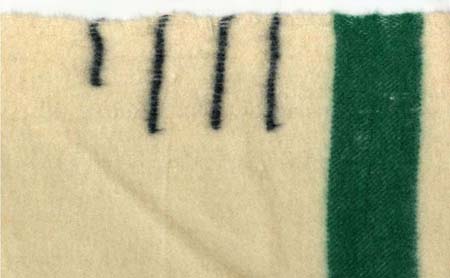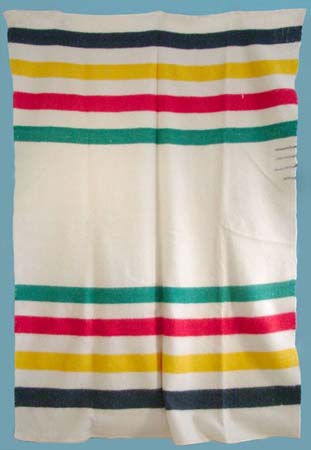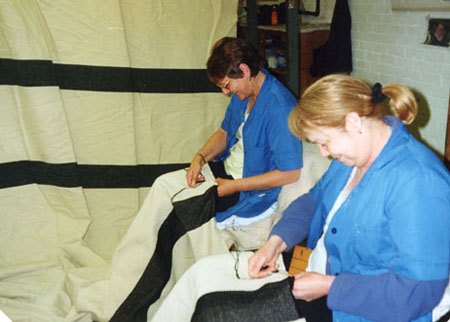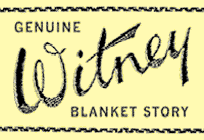

Point blankets and North AmericaPoint blankets are perhaps the Witney industry's most famous product. They were traded mainly with North America, where they came to have a cultural significance far beyond that of mere bed coverings. The origins of points Points were first used on blankets made for the domestic market in France during the 16th century; indeed the term 'point' is thought to come from the French verb 'empointer', meaning to make stitches on cloth. French traders had introduced the system to their blanket trade with North America by the 1690s. Blankets (typically of one to four points, in half-point steps) and other goods were traded with Native American peoples in exchange for a set number of beaver pelts, a fur in huge demand in Europe for the hat and clothing trade [2]. The number of points on a blanket was not originally intended to indicate that it should be traded for the same number of pelts, but that was often how they came to be used. Half points were worth either half a beaver skin, or an imperfect one [3]. The exchange rate of points-to-pelts varied from place to place and over time, however [4]. The North American market 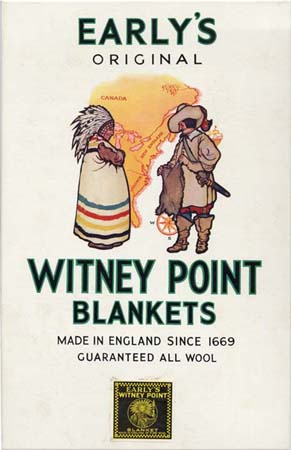 Early's advertising sign showing a point blanket trading between a Native American and an early merchant.  1970s advertising sign from Early's showing a hunter wearing a capote coat made from a point blanket. Point blankets were also valued by the many European settlers in North America. They are still popular there and are in demand as furnishings, collectors' items, gifts, souvenirs and for making into clothing as well as continuing to be a traditional source of warmth and comfort on the bed. Although no longer made in Witney they are still produced in quantity elsewhere and this has long been the case: in the past they have been made by many different firms in countries such as Canada, the Czech Republic, England, India, New Zealand and the USA. Witney and the point blanket trade '...of which Duffields and Blankets consists the chief Trade of Witney. These Duffields, so called from a Town in Brabant, where the Trade of them first began (whence it came to Colchester, Braintry, etc. and so to Witney) otherwise called Shags, and by the Merchants, Trucking-cloth; they make in pieces of about 30 yards long, and one Yard three-quarters broad, and dye them Red or Blue, which are the Colours that best please the Indians of Virginia and New-England, with whom the Merchants truck them for Bever, and other Furrs of several Beasts, etc., the use they have for them is to apparel themselves with them, their manner being to tear them into Gowns of about two Yards long, thrusting their Arms through two Holes made for that Purpose, and so wrapping the rest about them as we our Loose-coats. Our Merchants have abused them for many Years with so false Colours, that they will not hold their Gloss above a Months Wear; but there is an ingenious Person of Witney that has improved them much of late, by fixing upon them a true Blue Dye, having an Eye of Red, whereof as soon as the Indians shall be made sensible, and the disturbances now amongst them over, no doubt the Trade in those will be much advanced again' [7].Witney had first supplied the Hudson's Bay Company (HBC) with woven goods as early as 1681 but the town did not become a major provider to it until the 1730s, when James Empson started receiving regular HBC orders [8]. One of the earliest definite records we have for the supply of point blankets comes in December 1779, when five hundred pairs of 'pointed' blankets were ordered by the HBC from the firm of Thomas Empson (James' son). The demand for points then seems to have increased rapidly until the fur trade reached its height in the early 19th century.  Early's Witney Point blanket label showing the Native American symbol they adopted for their point blankets. Witney continued to supply the HBC with point blankets until the 1920s, when a rivalry seems to have developed between it and Early's. As well as supplying point blankets to the HBC, Early's had also begun marketing 'Genuine Indian Point Blankets' under their own label in Winnipeg in 1878 and supplying points to non-HBC outlets. Other British blanket manufacturers followed their example. This competition led to a series of threatened law suits by both companies in a struggle to gain control of the North American market for 'genuine' point blankets, a situation which was not resolved until 1949, when the two companies agreed terms out of court [12]. Early's had changed from being a supplier for HBC to becoming their major competitor in the point blanket trade.  A member of Early's staff seeing a roll of point blankets through one of the final stages in the production process.
|
|
| References [1] Tichenor 2003: p7 [2] Tichenor 2003: p9 [3] Plummer and Early 1969: p41 [4] Tichenor 2003: p12 [5] Tichenor 2003: p34 [6] Tichenor 2003: p43 [7] Plot 1677: pp278-280 [8] Plummer and Early 1969: p40 [9] Tichenor 2003: p32 [10] Plummer and Early 1969: p40 [11] Plummer and Early 1969: pp66-68 [12] Tichenor 2003: p40 |
|
